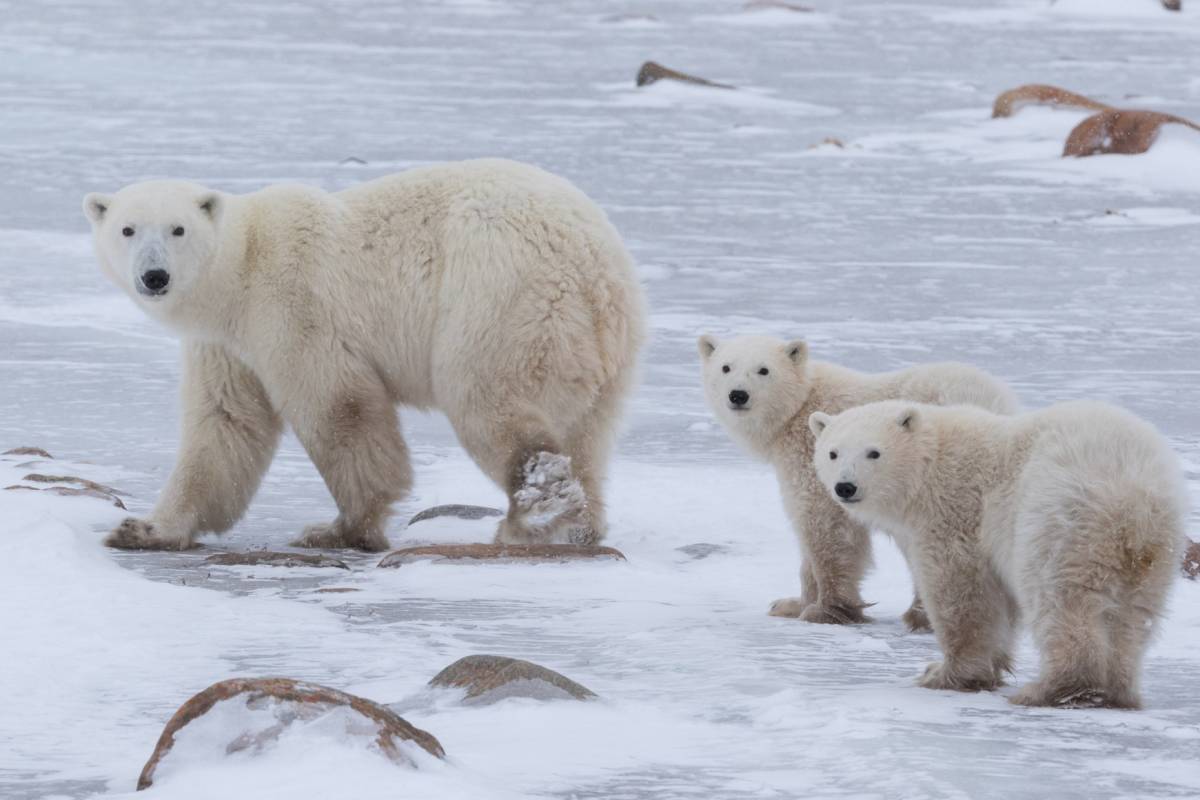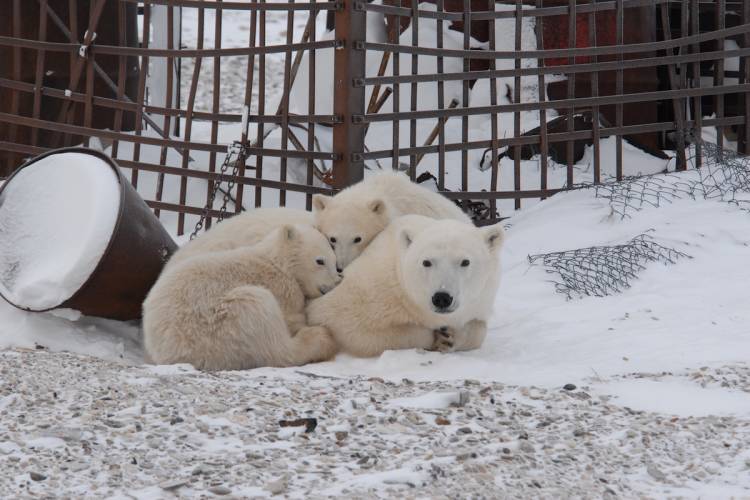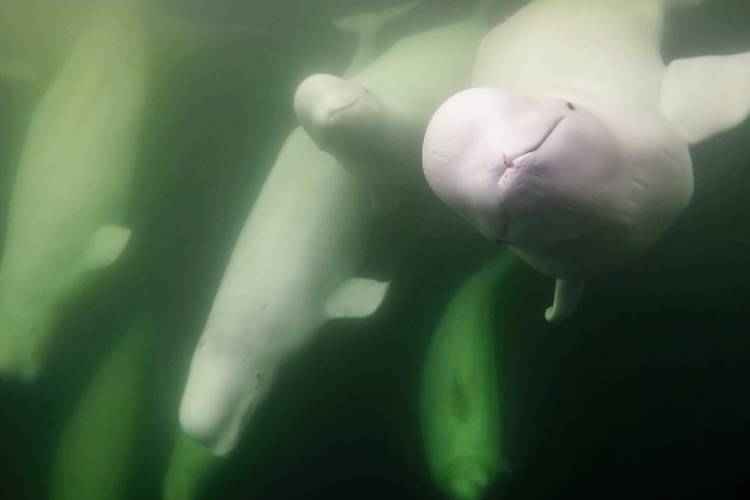CHURCHILL, CANADA – October 28, 2022 – Polar Bear Week is almost here, taking place October 30 - November 5, 2022. Polar Bears International (PBI), the only nonprofit organization dedicated solely to wild polar bears and Arctic sea ice, hosts this event to celebrate the Arctic, educate people around the world about polar bears and their melting ecosystem, and inspire people to get involved in sustaining their future.
“We love sharing the Arctic with everyone during Polar Bear Week, talking with people around the world about polar bears and this unique ecosystem,” says Alysa McCall, Polar Bears International Staff Scientist and Director of Conservation Outreach, adding, “Even from afar we can protect polar bears, and in turn the greater Arctic and Earth, by supporting community carbon-reduction projects and voting with the climate in mind. Every vote, at every level of government, matters as we encourage leaders to reduce emissions, creating a better world for polar bears and all of us.”
Polar Bear Week was created by Polar Bears International to coincide with the annual gathering of polar bears near Churchill, Canada, who wait for Hudson Bay’s sea ice to freeze so they can return to the ice to hunt seals. The bears are on the front lines of climate change, as the greatest threat to polar bears is sea ice loss due to human-caused climate warming.
Polar Bear Week is just ahead of the COP27 United Nations Climate Change Conference in Sharm El Sheik, Egypt, where global leaders will discuss reducing global emissions and other efforts to slow climate change. Polar Bears International will host a series of experts through its Tundra Connections live chat series from Churchill and from COP27 in Egypt. This chat series provides education and inspires people to get involved at every political level and election, and to make their voices heard.
Dr. Flavio Lehner, chief climate scientist at Polar Bears International and assistant professor in Earth and Atmospheric Science at Cornell University, comments on the importance of collective, systemic change: “During the pandemic, the whole world shut down and people stopped driving, flying, and made other changes in behavior. Yet total emissions dropped by only about 5%, showing how much emissions are baked into the systems that keep everything running: agriculture, factories, heating and cooling, and transportation. Individual action is not pointless, and collectively can help bring about shifts in social norms, but we need a systematic change towards producing energy and goods in carbon-neutral ways to reach our goal of stabilizing the climate.”
While climate change is the greatest overarching threat to polar bears, Polar Bears International is working to protect the world’s existing polar bears. Due to disappearing sea ice, polar bears are forced to stay on land longer. They are therefore fasting for longer – and looking for food in substances like human waste, leading to more human and polar bear interaction. During this year’s annual Polar Bear Week, Polar Bears International is focusing on coexistence solutions for polar bears and people. The nonprofit asks people to support its “Detect and Protect” initiatives, which include developing “Bear-dar” Artificial Intelligence radar systems to alert towns of approaching bears, a technology currently being tested in Churchill, Canada. Polar Bears International also supported the town of Churchill in establishing the world’s first polar bear-safe community, with a goal of minimizing negative encounters between people and polar bears so both can thrive, and continues to work with the town bear-safe measures.
Polar Bear Week is focused on protecting polar bears and people, with Polar Bears International developing coexistence technology and conducting field research projects this fall:
“Protect and Detect Polar Bears” bear-dar development: Polar Bears International continues to test and train the “SpotterRF” artificial intelligence radar system to detect bears and alert the community, along with other “Detect and Protect” ground-based radar systems to assess their potential in alerting authorities day or night if polar bears approach the town. If successful, these systems could help communities reduce human-polar bear conflict.
New in 2022, Polar Bears International mounted one of the radar units on a new mobile tower that will be tested in corridors known to be frequent paths traveled by polar bears near the community.
In addition to SpotterRF, this year the team will test two other promising bear-dar systems during bear season, from Hensoldt and from Brigham Young University.
3M Bear Trackers: Polar Bears International continues testing around prototype temporary stick-on tracking tags developed with research scientists at 3M. Known as the Burr on Fur project, the goal is to create a minimally invasive way of tracking wildlife. In addition to testing the Burr on Fur tags on wild polar bears in Canada, Polar Bears International continues to work with their Arctic Ambassador Center network to test them on bears in captivity at participating zoos as well
“2022 represents another advancement of human and bear coexistence in Churchill with the addition of a new tower to host the “bear-dar,” while researchers are honing the radar’s Artificial Intelligence and testing new technologies,” says Krista Wright, Polar Bears International Executive Director, noting, “The programs being piloted in Churchill will be pivotal to polar bear coexistence efforts around the Arctic and more broadly, will impact the understanding of other species.”
How people can get involved in Polar Bear Week:
Watch Polar Bear Live Cams: powered by explore.org, the largest live nature network in the world, along with Frontiers North Adventures, Parks Canada and the Churchill Northern Studies Center. There are several live cams, including some mounted on Tundra Buggies driving around Wapusk National Park. The Tundra Buggies are provided by Frontiers North Adventures, a leader in sustainable tourism, who just added a new zero-emission electric vehicle Tundra Buggy to the fleet.
The cams offer a window into the polar bear’s world, offering close-up views of moms snuggling with cubs, large males sparring, and young bears testing the ice along the shore.
In addition to polar bears, other wildlife often make appearances, including Arctic foxes, snowy owls, ptarmigan, and Arctic hares.
Play Polar Bear Bingo while you watch the cams!
Tune into Tundra Connections to chat with polar bear scientists and experts. Tundra Connections are live streamed from Churchill to hundreds of thousands of viewers, facilitating discussions about polar bears and how people can help. All webcasts are supported by new, free learning materials. This year, Polar Bears International is once again partnering with Discovery Education, Connected North, Microsoft Flip, and explore.org. Highlights from the schedule include:
Polar Bear Research: Join Polar Bears International’s new scientists, Chief Climate Scientist Dr. Flavio Lehner and Chief Research Scientist Dr. John Whiteman, for insights into their work on November 1 at 2 pm ET
Decision-Making Mamas: Talk about polar bear moms with Polar Bears International Staff Scientist Alysa McCall and new Chief Research Scientist Dr. John Whiteman on November 3 at 1 pm ET
Live from COP27: Join Polar Bears International representatives at the UN Climate Change Conference in Sharm El Sheik, Egypt. Tune-in November 8, noon ET
Watch a video about the “Detect and Protect” initiative.
Take Polar Bears International’s Detect and Protect Polar Bears fundraising challenge and invite your friends and family to get involved in a cause you are passionate about.
Symbolically Adopt a Polar Bear
Donate to Protect Polar Bears and People
By helping us develop early warning systems for use by Arctic communities, donors can help polar bears and people coexist, keeping both from harm.
Climate warming will be the focus of the COP27 United Nations Climate Conference and present the perfect time to talk about the impact that climate change poses to the Arctic and the species who rely on the ecosystem for survival. Across the Arctic, most polar bears are likely to disappear by 2100 unless we shift away from burning fossil fuels, and shift to renewable energy sources. Although the annual gathering of polar bears near Churchill is part of an age-old pattern, climate warming has caused Hudson Bay to melt earlier in summer and to freeze later in the fall, with the summer ice-free period three to four weeks longer than it was in the 1980s. As a result, the Churchill population of polar bears (Western Hudson Bay) has experienced a 30% decline since the early 1980s. On land the bears’ fat reserves are strained, and each day on land they lose about two kilograms per day of body weight. By reducing greenhouse gas emissions, we can slow climate change, in turn protecting polar bears and people.
Last year’s Polar Bear Week included participation from Parks Canada, Explore.org, Annenberg Foundation, Frontiers North Adventures, Alaska Wilderness League, Association of Zoos and Aquariums, Canadian Geographic, Defenders of Wildlife, Discovery Education, Environment and Climate Change Canada, EcoWatch, Government of Canada - North, Ontario Department of Natural Resources, Peppermint Narwhal, Shared Planet, The Weather Network, The Wildlife Collective, and the Alaska Zoo, Assiniboine Park Zoo, Aquarium du Quebec, Brookfield Zoo, Buffalo Zoo, Columbus Zoo, Como Zoo, Indianapolis Zoo, Munich Zoo, Oregon Zoo, Ouehands Zoo, Pairi Daiza Zoo, Pittsburgh Zoo, Point Defiance Zoo, Saint Louis Zoo, San Diego Zoo Wildlife Alliance, San Francisco Zoo, Smithsonian’s National Zoo, Tierpark Berlin, Toronto Zoo, Wildlife Conservancy, Utah’s Hogle Zoo, Yorkshire Wildlife Park and YWP Foundation, Zoo De La Fleche, Zoo Hannover, Zoo Rostock and more organizations.
Outside of Polar Bear Week, Polar Bears International focuses on conservation efforts year-round and relies on global support to make the most impact.
About Polar Bears International
Polar Bears International’s mission is to conserve polar bears and the sea ice they depend on. Through media, science, and advocacy, we work to inspire people to care about the Arctic, the threats to its future, and the connection between this remote region and our global climate. PBI is the only nonprofit organization dedicated solely to wild polar bears and Arctic sea ice, and our staff includes scientists who study wild polar bears.The organization is a recognized leader in polar bear conservation. For more information, visit www.polarbearsinternational.org.
About explore.org
Founded in 2004 by Charles Annenberg Weingarten, Director and Vice President of the Annenberg Foundation, explore.org is a philanthropic multimedia organization with a mission to champion the selfless acts of others and create a portal into the natural world. With over 100 live streaming cameras, explore.org is the largest live nature network in the world.
About Frontiers North Adventures
A certified B Corporation® and leader in sustainable travel since 1987, Frontiers North specializes in authentic adventures in Canada’s North, providing guests with the opportunity to experience the wildlife, history and culture of its people. Owners-and-operators of the official Tundra Buggy®, Frontiers North offers a variety of tour programs, the most popular being polar bears in Churchill. www.frontiersnorth.com
Media Contacts
Annie Edwards, for Polar Bears International
annie@fabricmedia.net
Melissa Hourigan, for Polar Bears International
melissa@fabricmedia.net
720-608-1919

















